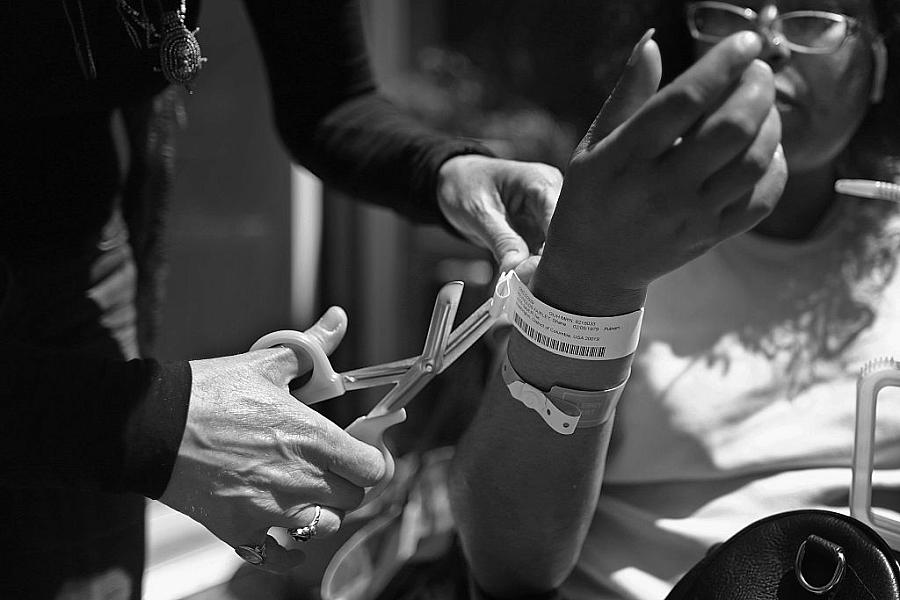Sickle cell disease patients navigate a legacy of systemic racism

(Photo by Chip Somodevilla/Getty Images)
This is a story about how racism that happened decades ago can live on and affect the health of people living today.
During World War II and Pearl Harbor, Black Americans were turned away from donating blood because at that time their blood was deemed unfit to go into a White soldier’s body. In fact, the Red Cross itself kept blood segregated –– not based on any scientific evidence at the time, but out of racism.
Today, less than 3% of blood donors are African American and that’s a big problem, especially for Black Americans who need frequent blood transfusions to deal with certain blood diseases like sickle cell disease. These patients sometimes have to wait for days –– risking strokes, organ failure or even death –– before they get lifesaving blood transfusions because it is so hard to find their match in such a small pool of donors.
But that’s just the tip of the iceberg.
Looking at the health care system through the lens of a sickle cell disease patient is a litmus test for how equitable the system is, for a simple reason: nearly all sickle cell disease patients are Black or of African descent.
Sickle cell patients are not a priority
An estimated 100,000 Black Americans are living with the disease –– that’s one out of every 365 African Americans. But one out of every 13 African Americans are born with the sickle cell trait, which could eventually manifest as sickle cell disease.
The sickle cell disease community is typically poorer and more likely to be uninsured, factors that can be traced back to systemic racism. They also do not have as much bargaining power when it comes to health policies and are more hesitant to seek needed care. And in many ways, they are seen as less profitable to treat. In turn, they receive less attention when it comes to public spending and research funding for cutting-edge therapies.
A study in 1994 showed that adult life expectancy for sickle cell disease patients is 45 years for women and 42 for men. A similar study, more than a decade later, showed that the situation had worsened: life expectancy was slashed to 42 for women and 38 years for men. Years are shaved off young Black men and women’s lives that could have potentially been saved if more support and better care existed.
Sickle cell disease is not a mild illness by any measure. But the way the system is set up right now pushes patients to seek care in primary care clinics –– which experts say is far from appropriate for a complex, chronic condition. This is comparable to directing a brain cancer patient to primary care –– rather than an oncologist or neurosurgeon –– every time their cancer flares up.
There are half as many specialized centers for sickle cell disease providing multidisciplinary comprehensive care nationwide as there are centers for diseases like hemophilia and cystic fibrosis, which are of similar complexity but affect more White patients. When it comes to research funding, cystic fibrosis, which is less than a third as common as sickle cell disease, receives more than 11 times the amount of federal dollars.
Improving care for sickle cell patients will also require cutting health care costs. A number of studies show individuals with sickle cell disease had three times the charges for hospitalization associated with an ED visit (per 100 patients with the disease) compared with those with congestive heart failure. Other studies showed that patients treated in specialized centers had fewer ED visits, lower admission rates and shorter hospital stays. This translates into lower fees for both the payer and the institution.
The real-life toll of sickle cell disease
The pandemic has exacerbated many health disparities. But the issues faced by sickle cell patients date back decades and are tied to genetics, economic struggles, social status and the health care industry's long history of racist practices and policies.
My reporting project, supported by the 2022 Impact Fund for Reporting on Health Equity and Health Systems, will focus on an underrepresented and underreported population that is facing layers of systemic racism on top of their debilitating health problems.
In my reporting, I will speak with patients, tap into support groups, interview researchers, physicians, health historians, Centers for Medicare and Medicaid Services officials, and public policy experts. I will focus part of my reporting on solutions, by visiting sickle cell disease comprehensive care centers to convey how different patients’ outcomes are.
Exploring the different layers of a person living with sickle cell disease will help illuminate how these issues are intertwined and deeply entrenched in the system’s fabric. This allows for a narrative-driven exploration of the intersection between systemic racism and health outcomes.
The issues facing sickle cell disease patients are not new but addressing them is long overdue. We are at a moment when the COVID-19 pandemic coupled with the country’s racial reckoning has resulted in increased awareness of longstanding issues of racism in society, including health care, and it’s time to shine a light on the sickle cell disease community.

